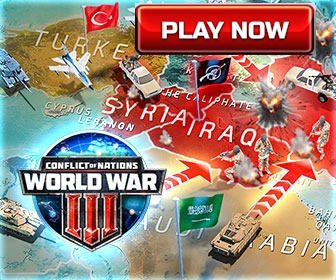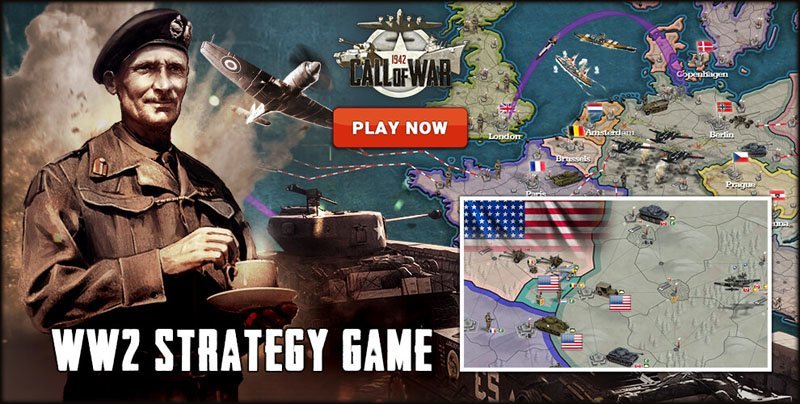US long-range fighter and fighter-bomber Lockheed P-38 Lightning.
History, development, service, specifications, statistics, pictures and 3D model.
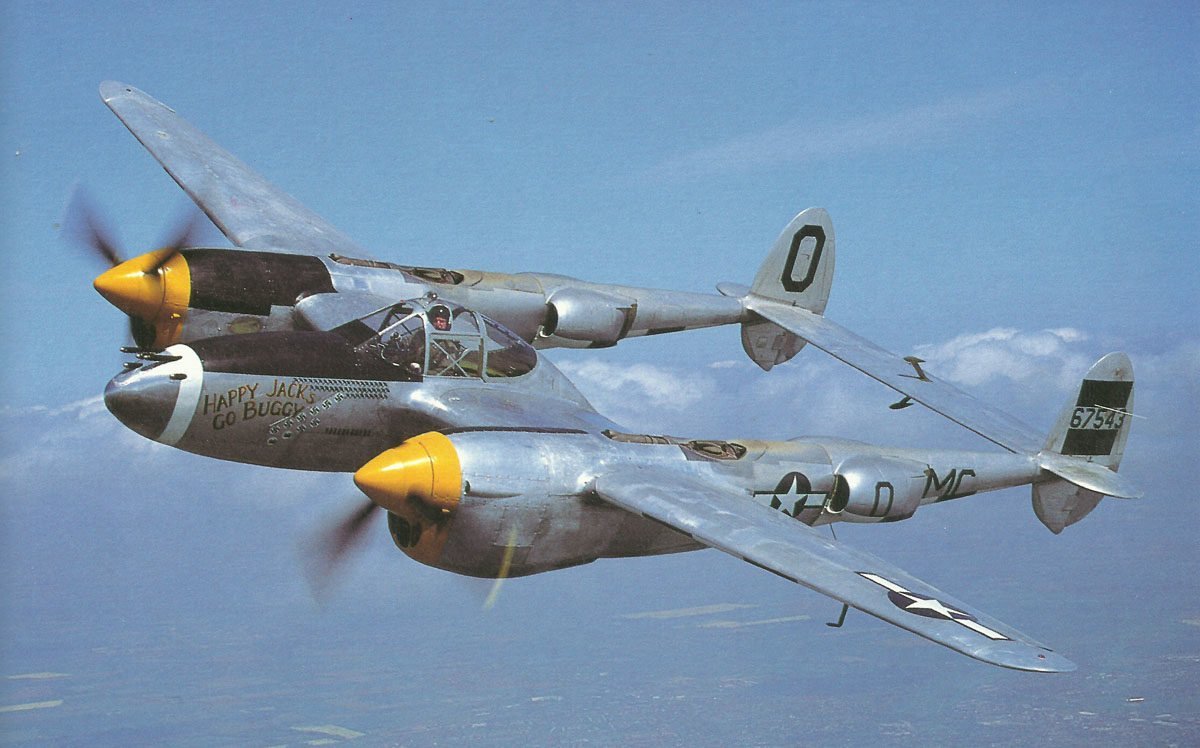
Lockheed P-38 Lightning
Table of Contents
Lockheed P-38 Lightning
Type: US long-range fighter, fighter-bomber, photographic reconnaissance aircraft, night fighter.
Overview
The Lockheed P-38 Lightning was a World War II-era American fighter aircraft. It was developed by Lockheed Corporation and had a distinctive twin-boom and central nacelle design. Here is a overview about the P-38 Lightning:
Design: The P-38 featured a unique twin-boom design with a central nacelle housing the cockpit and armament. This configuration allowed for a concentrated fire from its nose-mounted guns.
Engines: It was powered by two Allison V-1710 liquid-cooled engines, one in each boom, making it one of the fastest fighters of its time.
Armament: The P-38 was heavily armed with a combination of 20mm cannons and .50-caliber machine guns mounted in the nose.
Versatility: The aircraft was used in various roles, including interception, dive bombing, level bombing, ground attack, night fighting, photo reconnaissance, and even as a long-range escort fighter when equipped with drop tanks.
Theaters of operation: P-38s were used in the European Theater, Pacific Theater, Mediterranean Theater, and the China-Burma-India Theater during World War II.
Famous pilots: Several notable pilots flew the P-38, including America’s top ace Richard Bong (40 victories) and Thomas McGuire (38 victories).
Nickname: The P-38 was nicknamed the ‘Fork-Tailed Devil’ by the German Luftwaffe and ‘Two Planes, One Pilot’ by the Japanese.
The P-38 Lightning played a significant role in World War II, serving in various capacities across multiple theaters of operation, and remained in service with the United States Army Air Forces until the end of the war.
History
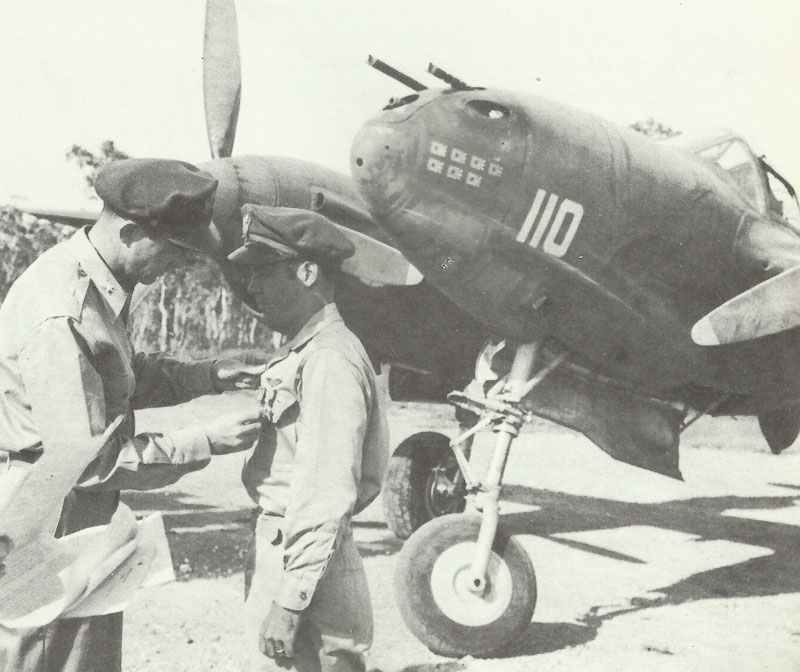
The P-38 Lightning shot down more Japanese aircraft than any other fighter plane. In April 1943 a P-38 Lightning shot down the aircraft carrying Admiral Yamamoto, the man who had planned the Pearl Harbor attack. The Germans called the P-38 Lightning ‘Gabelschwanz-Teufel’ (‘The Devil with the Cleft Tail’).
The two leading American WW2 aces, Major Richard I. Bong and Major Thomas B. McGuire, made their last kills in the P-38. Bong shot down all his adversaries in a P-38 and had a total of 40 kills, while McGuire’s total was 38.
In February 1937 the US Army Air Corps issued a specification for a long-range interceptor (pursuit) and escort fighter, calling for a speed of 360 mph (ca. 579 km/h) at 20,000 ft (ca. 6,096 m) and endurance at this speed of one hour. Lockheed, which had never built a purely military design, jumped in with both feet and created a revolutionary fighter bristling with innovations and posing considerable technical risks.
Powered by two untried Allison engines, with GEC turbochargers recessed into the tops of the tail booms, it had a tricycle landing gear, small central nacelle mounting a 23 mm Madsen cannon and four 0.5in Brownings firing parallel directly ahead of the pilot, twin fins, Fowler flaps, cooling radiators on the flanks of the booms and induction intercoolers in the wing leading edges.
This box of tricks ran into a ditch on its first taxi test and two weeks after first flight undershot at Mitchell Field, NY, and was demolished.
What made headlines, however, was that it had flown to New York in 7hr 2min, with two refueling stops, demonstrating a performance which in 1939 seemed beyond belief.
In view of the efforts that the Germans made to put a heavy twin-engined fighter like the Me 110 into the field, the team which drew up the specification for the P-38 was subsequently able to congratulate itself on its part in producing one of the best fighters of WW2.
At the end the enthusiasm of the Air Corps overcame the doubts and high cost and by 1941 the first YP-38 was being tested, with a 37 mm Oldsmobile cannon, two 0.5s and two Colt 0.3s machine-guns. Thirteen YP’s were followed on the Burbank line by 20 P-38s, with one 37 mm and four 0.5, plus armor and, in the 36 D models, self-sealing tanks.
In March 1940 the British Purchasing Commission had ordered 143 of this type, with the 37 mm replaced by a 20 mm Hispano cannon and far greater ammunition capacity. The State Department prohibited export of the F2 Allison engine and RAF aircraft, called Lightning I, had early C15 engines without turbochargers, both having right-hand rotation (P-38s had propellers turning outward). The result was poor, and the RAF rejected these machines, which were later brought up to US standard.
The E model adopted the British name Lightning and the RAF Hispano gun. Within minutes of the US declaration of war, on 7 December 1941, an E shot down a German Fw 200C near Iceland, and the P-38 was subsequently in the thick of fighting in North Africa, North West Europe and the Pacific.

The F was the first to have inner-wing pylons for 1,000 lb (453.59 kg) bombs, torpedoes, tanks or other stores.
By late 1943 new G models were being flown to Europe across the North Atlantic, while in the Pacific 16 aircraft of the 339th Fighter Squadron destroyed Admiral Yamamoto’s aircraft 550 miles (ca. 885 km) from their base at Guadalcanal.
The J had the intercoolers moved under the engines, changing the appearance, providing room for 55 extra gallons of fuel in the outer wings. Later J models had hydraulically boosted ailerons, but retained the wheel-type lateral control instead of a stick.
The L, with higher war emergency power, could carry 4,000 lb (1,814.37 kg) of bombs or ten rockets, and often formations would bomb under the direction of a leadship converted to droop-snoot configuration with a bombardier in the nose.
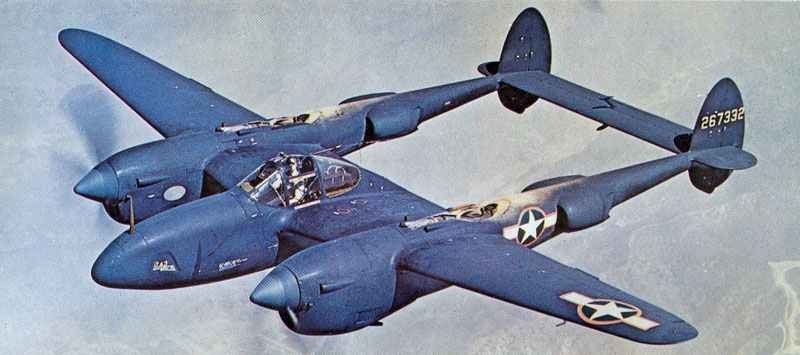
Hundreds were built as F-4 or F-5 photographic reconnaissance aircraft, and the M was a two-seat night fighter with ASH radar pod under the nose.
Lightnings towed gliders, operated on skis, acted as fast ambulances (carrying two stretcher cases) and were used for many special ECM missions.
Total production was 9,942 and the P-38 made up for slightly inferior maneuverability by its range, reliability and multi-role effectiveness.
Animated 3D model P-38 J Lightning
Specifications Lockheed P-38 F Lightning
Specifications:
P-38 F Lightning | Specification |
|---|---|
Type | Long-range fighter and fighter-bomber |
Power plant | Two Allison V-1710-49, 12 cylinder V, liquid-cooled 1,250 hp engines |
Accommodation | 1 |
Wing span | 52 ft |
Length overall | 37 ft 10 in |
Height overall | 9 ft 10 in |
Weight empty | 12,500 lb |
Weight loaded | 20,000 lb |
Maximum speed | 395 mph |
Initial climb | 2,850 ft/min. |
Service ceiling | 39,000 ft |
Range | 1,425 miles |
Armament:
P-38 F Lightning | Specification |
|---|---|
in front direction | 20 mm Hispano cannon (650 rpm; velocity 2,850 ft/s), four 0.50in machine guns (800 rpm; velocity 2,810 ft/s) |
external load | 2,000 lb of bombs |
Service statistics:
P-38 Lightning | figures |
|---|---|
First flight XP-38 | 27 January 1939 |
First service delivery (P-38) | 8 June 1941 |
Production delivery P-38E | November 1941 |
Production delivery P-38F | early 1942 (service delivery: September 1942) |
Final delivery P-38M | September 1945 |
Production figures | 30 P-38; 36 P-38D; 210 P-38E; 1,082 P-38G; 601 P-38H; 2,970 P-38J; 3,923 P-38L (total: 9,923) |
No. of Sorties in Europe 42-45 | 129,849 |
Bomb Tonnage in Europe 42-45 | 20,139 t |
US Lost in Combat in Europe 42-45 | 1,758 |
Enemies claimed Destroyed in air, Europe 42-45 | 1,771 |
Enemies claimed Destroyed on ground, Europe 42-45 | 749 |
Animated 3D model P-38 Lightning F-5 photographic reconnaissance aircraft
References and literature
Combat Aircraft of World War II (Bill Gunston)
Technik und Einsatz der Kampfflugzeuge vom 1. Weltkrieg bis heute (Ian Parsons)
Das große Buch der Luftkämpfe (Ian Parsons)
Luftkrieg (Piekalkiewicz)
Flugzeuge des 2. Weltkrieges (Andrew Kershaw)
World Aircraft World War II (Enzo Angelucci, Paolo Matricardi)
The Encyclopedia of Weapons of World War II (Chris Bishop)



